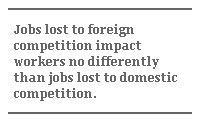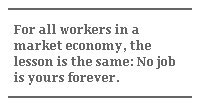Tangled Threads of Protectionism – Part III
Tangled Threads of Protectionism – Part III

ANN ARBOR, Michigan: Last year, it was the uproar over the offshore outsourcing of service sector jobs. This year, it is the loss of manufacturing jobs in textile sector. The recent spate of layoffs in the US and other countries' textile industries – blamed on the rise in China's textile exports following the expiry of three-decades-old quotas – have raised anew the vexed question: How can one protect jobs in a competitive global market?
Job loss is not peculiar to globalization; rather, it is the norm in any dynamic market economy. The shifting forces of supply and demand – underlain by changes in technology, consumer preferences, corporate restructuring, and labor force demographics – constantly create new jobs, destroy some old ones, and move yet others to more competitive domestic or foreign locations. Globalization only intensifies this process.

Today's calls for trade sanctions against China to protect jobs in other countries are misguided and likely to be ineffective. Rather, governments, companies, and individual workers need to invest in education, innovation, and forward planning to adjust to the new realities of the global marketplace.
Because job turnover is so common, and so natural, in market economies, most industrial countries have long since developed public policies to deal, however inadequately, with its human and social impacts. These policies are mainly unemployment income compensation, and retraining and job placement subsidies, to tide workers over when they are between jobs, and help them acquire new ones. In addition, full employment in a healthily-growing economy is the best insurance against the woes of joblessness.
Jobs lost due to foreign competition are no different in their impact on workers than the far greater number of jobs lost to domestic competition, technological change and market shifts. But because they arouse nativist objections, and may threaten trade liberalization, countries like the US provide additional "trade adjustment assistance" privileges to workers laid off due to import competition.

Trade protection, though often called for, is no solution to the problem. At best it postpones the day of reckoning, and at worst it discourages employers and workers from adjusting to their underlying loss of competitiveness. It also taxes consumers' pockets through higher prices, thus discouraging job creation in other sectors where they might otherwise spend their money.
The Multi-Fiber Agreement (MFA) protection for developed countries' textile and clothing industries is a case in point. More than three decades of protection from imports – and ten years advance warning that this protection would end on January 1, 2005 – did little to stimulate the investments by employers and workers necessary to remain globally competitive in, or to exit, the labor-intensive industry. Job loss in the industry was slowed, but not halted or reversed.
In the same way, renewed textile protection today would do little to "save jobs" in uncompetitive developed countries, but would hurt workers in competitive developing countries. In efficiency and equity terms, more job creation for workers in poor countries, and more disposable income for consumers in rich countries, resulting from free trade in textiles, are both good. Workers laid off in rich countries should be compensated by temporary income and retraining subsidies through national public policies, as most already are.

But what about workers laid off in poor countries which lack the public policies and government financial resources that fund income-compensation schemes in rich countries? Since these countries invested in textile exports because of rich countries' market-distorting trade policies (which created artificial demand for their exports through country-specific quotas), it is arguable that rich countries should compensate the poor country workers now losing their jobs in this sector. After all, rich countries' consumers are the main beneficiaries of the end of MFA (through cheaper clothing costs), and their governments and taxpayers are much better able to fund such compensation than poor countries' governments and taxpayers. Although such cross-border compensation is unusual, it is not unheard of – for example, in the case of war reparations.
The US Congress and textile industry interests are calling instead for safeguard tariffs on textile imports from China, claiming that it is competing "unfairly" – is not market-competitive – in the labor-intensive textile industry. Their first argument is that China is competitive only because it is "manipulating" its currency – by maintaining its 11-year-old peg against the declining US dollar, which keeps the currency artificially low. Their second is that China is competitive only because its workers are grossly exploited, particularly because China, like many other developing countries, does not allow independent labor unions.
Whatever the merits of these two arguments, the policies proposed to counter them are more than likely to be ineffective or worse, particularly in terms of the impact on workers.

Suppose that China were to give up its currency peg now, and that its currency appreciates against the dollar, most likely by 10 percent or 15 percent (depending on the exact mechanism of the re-peg). Like other countries (such as Japan), which have maintained trade surpluses against the US despite appreciating currencies, this does not necessarily translate into higher US dollar prices for China-made goods. To the extent that China's garments exports embody imported materials and equipment, the stronger currency will actually reduce their costs. Exporters in China may also decide to cut their profit margins to maintain dollar prices, or they may exert downward pressure on labor costs; if this fails to maintain competitiveness, they will shut down operations and fire their workers.
Either way, Chinese workers will be the losers, while American workers are unlikely to gain. More likely than not, labor-intensive textile imports diverted from China will come from other labor-abundant developing countries instead, including countries (such as Vietnam) without independent labor unions. And, if Chinese workers are grossly exploited, weakening market demand for their labor will only worsen their situation and made it more difficult for independent labor unions to emerge.
The lesson for US textile companies which are not market-competitive with China is that they need to invest more heavily in automation, new technology, moving up the value chain, and relocation overseas (not necessarily to China itself) – all the measures that decades of protection have discouraged in the US, but encouraged in China.
For both US and Chinese textile workers, the lesson is the same as that for all workers in a market economy (such as Taiwan, which suffered from proportionately greater and much faster job losses with China's rise): no job is yours forever, and workers need to save from current income to accumulate capital or invest in upgrading their education and skills, so that they are occupationally mobile when the time comes. This includes starting up their own small enterprises, which many laid-off textile workers already do in developing countries like Cambodia and Indonesia, where other wage jobs are much scarcer than they are in developed countries. Public or private microcredit enterprises – perhaps funded by aid from developed countries – can provide some of the capital.
Public policy can and should help in this adjustment, both within and across borders, by providing income and educational assistance to workers adversely affected by loss of competitiveness. Labor unions seeking to help their members and workers in other countries would do better to lobby for more generous adjustment policies – such as income compensation, wage insurance and benefit extensions – than for trade protection which would reduce consumers' purchasing power in importing countries (especially hurting lower-income consumers, including union members), and deny jobs, income and bargaining power to poorer workers in China.
Linda Lim is Professor of Corporate Strategy and International Business at the University of Michigan Business School.